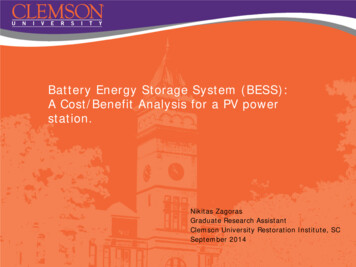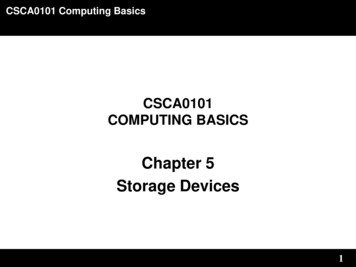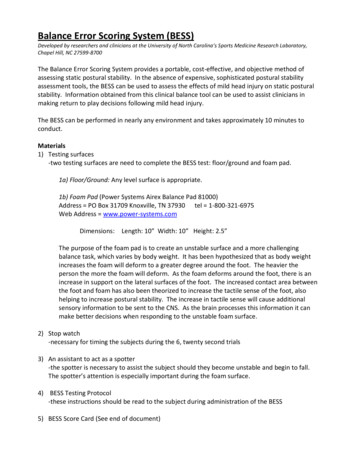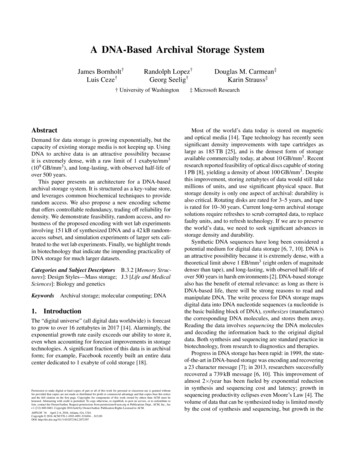
Transcription
Battery Energy Storage System (BESS):A Cost/Benefit Analysis for a PV powerstation.Nikitas ZagorasGraduate Research AssistantClemson University Restoration Institute, SCSeptember 2014
Cost/Benefit Analysis: Step by Step The cases used for distribution system simulations: IEEE 13 Node Test Feeder case IEEE 34 Node Test Feeder case BESS sizing: System capabilities Applications intended to be supported BESS placement: Power losses minimization Power line voltage limits Calculating the cost and revenue generatedby the applications for a BESS (Li-Ion) Evaluating the investment and buildinga business case
Cost Analysis: BESS ApplicationsFive Categories ofEnergy StorageApplicationsEnergy Storage for the Electricity Grid Benefits and MarketPotential Assessment by Sandia NL 2010
Cost Analysis: Applications Synergies MatrixEnergy Storage for the Electricity Grid Benefits and Market Potential Assessment by Sandia NL 2010
Cost Analysis: Application Power Ratings (kWs - MWs)Energy Storage for the Electricity Grid Benefits and Market Potential Assessment by Sandia NL 2010
Cost Analysis: Application Duration Ratings (sec - hrs)Energy Storage for the Electricity Grid Benefits and Market Potential Assessment by Sandia NL 2010
Cost Analysis: Cost Breakdown1. Capital cost or plant financial carrying chargesa. Storage System footprint and space requirements (Energy andPower density).b. BESS (batteries, power converters, etc.)c. Facility infrastructure (communications and control, environmentalcontrol, grid interconnection, etc.)2. Total operating cost:a. Cost for charging the systemb. Labor associated with plant operationc. Plant maintenanced. Replacement and repair coste. Decommissioning and disposal cost
Cost Analysis: BESS - Capital Costs The cost of the storage unit:Coststorage ( ) Unit Coststorage( /kWh) * E(kWh) All systems have some inefficiency factor (η) hence:Coststorage( ) Unit Coststorage( /kWh) * (E(kWh) / η) The cost of the Power Conversion System is:Costpcs ( ) Unit Costpcs( /kW) * P(kW) The Total Cost is:Costtotal( ) Costpcs( ) Coststorage( ) When, the unit costs of the subsystems are known, and the storage capacityin kW is known, it is possible to rewrite the total cost in terms of the powerrating:Costsystem ( /kW) Costtotal( ) / P(kW)Energy Storage Systems Cost Update by Sandia NL 2011
Cost Analysis: Utilizing Used Li-Ion Batteries. A new 15 kWh battery pack currently costs 990/kWh to 1,220/kWh(projected cost: 360/kWh to 440/kWh by 2020). The expectation is that the Li-Ion (EV) batteries will be replaced with a freshbattery pack once their efficiency (energy or peak power) decreases to 80%.Based on various forecasts for market penetration of PHEVs and EVs overthe next 10 years, a large number of PHEVs and EVs will be approachingthis 80% efficiency level by 2020. These batteries can be recycled or used inother less demanding applications for the rest of their useful life provided abusiness case can be made for their secondary use. The minimum goal for a selling price for a Used Li-Ion Batteries is less than 150/kWh for 25,000 units at 40 kWh.Economic Analysis of Deploying Used Batteries in Power Systems by Oak Ridge NL 2011
Benefit Analysis: Revenue Generating Applications1.2.3.4.Electric Energy Time-ShiftLoad FollowingRenewables Energy Time-ShiftRenewables Capacity Firming
Benefit Analysis: Electric Energy Time-Shift Basic concept: Buy low / Sell high Key elements: Hourly prices Round trip efficiency Discharge duration For about 900hrs/year the price is 100/MWhr* (peak time) For about (8760-900) 7860hrs/year the price is 50 60/MWhr*(off-peak time)Decision making process: If the cost for wear on the storage system,plus the cost for charging energy, plus the cost to make up for storagelosses exceeds the expected benefit, then the transaction is not made. The generic benefit estimate for Electric Energy Time-Shift rangesfrom 400/kW to 700/kW (over 10 years).*Wholesale Electricity Price Forecast data provided by Joel Klein, California Energy Commission 2008Energy Storage for the Electricity Grid Benefits and Market Potential Assessment by Sandia NL 2010
Benefit Analysis: Renewables Energy Time-Shift Similar concept Electric Energy Time-Shift but with emphasis onthe renewable energy source. Instead of selling off-peak energy in real-time (when generated),that energy is stored and used at a later time when energy pricesare high. Peak time 12:00 pm – 5:00 pm Storing low-priced energy from the grid and directly from renewableenergy generation means that there is more energy output from therenewable energy plus storage system than could be delivered if onlyenergy from renewable energy generation is stored. The generic benefit estimate for Renewables Energy Time-Shiftranges from 233/kW to 389/kW (over 10 years).Energy Storage for the Electricity Grid Benefits and Market Potential Assessment by Sandia NL 2010
Benefit Analysis: Load Following The benefit consists of two possible scenarios: Marginal cost: Cost for fuel and variable maintenance Low end cost 20/MW per hour (hydroelectric plant) High end cost 50/MW per hour (combined cyclegeneration) Capacity cost: Cost for additional generation capacity A simple cycle combustion turbine costs 60/kW-year A combined cycle plant costs 120/kW-year The generic benefit estimate for Load Following ranges from 359/kW to 710/kW (over 10 years).Energy Storage for the Electricity Grid Benefits andMarket Potential Assessment by Sandia 2010
Benefit Analysis: Renewables Capacity Firming A well-optimized, solar generation facility can have a 0.80 capacitycredit. Whereas another solar generation facility might be firmed with acapacity credit of 0.40 (i.e., distributed, flat panel PV modules with asuboptimal and fixed orientation, regular dust accumulation, shading bysurroundings, high ambient temperatures, high level of cloudiness,etc.). Adding storage to distributed fixed-orientation PV is assumed toincrease the capacity credit from 0.40 to 1.0. The renewables capacity firming benefit estimated for adding storageto renewable energy generation is incremental. Consequently, thefinancial merits of adding storage to renewables generation, theincremental benefit is compared to incremental cost (to add storage). The generic benefit estimate for Renewables CapacityFirming ranges from 709/kW to 915/kW (over 10 years).Energy Storage for the Electricity Grid Benefits and Market Potential Assessmentby Sandia 2010
Cost/Benefit Analysis: Summary PhasePhasePhasePhase1:2:3:4:Define Grid ServicesIdentify Feasible Use CasesUnderstand Grid ImpactsForm Business CasesCost-Effectiveness of Energy Storage in California by EPRI 2013
Future Work Apply different methods to evaluate an investment in BESS: Rate of Return Payback time Net Present Value SWOT analysis Evaluate a system with and without an BESS (comparative study) Hardware testing of a BESS (eGRID)
renewable energy plus storage system than could be delivered if only energy from renewable energy generation is stored. The generic benefit estimate for Renewables Energy Time-Shift ranges from 233/kW to 389/kW (over 10 years). Energy Storage for the Electricity Grid Benefits and Market Potential Assessment by Sandia NL 2010 .










